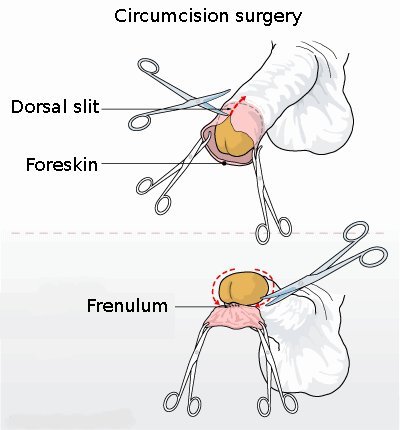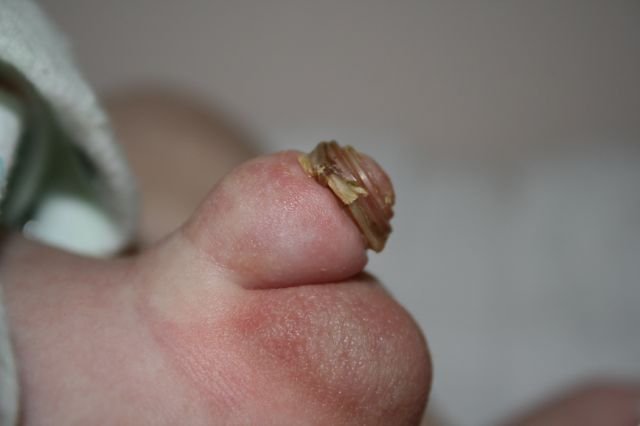Circumcision in some contemporary African society
Circumcision technically refers to the practice of removing the foreskin of the male genitalia, the penis, in order to reveal the glans penis. It is a practice that dates as far back as ancient years ago and remains even popular till today in the face of modernization and advancement in technology. Statistically, about 30% of males are circumcised globally. The popularity is entrenched in the medical benefits circumcised genitalia offers; including but not limited to easier washing of the penis, reduction in the risk of urinary tract and sexually transmitted infections, reduction in the risk of mechanical damages to the penis as well as reduced risk of penile cancer.

Some people arguably opine that circumcised penises look more aesthetically pleasing than uncircumcised ones but that can be said to be subjective. Beauty, they say, is in the eyes of the beholder. However, just as there exists opposition to virtually everything scientifically good or bad in this world, some groups exist that are totally against male circumcision.
The practice of male circumcision is widely spread in Africa and it is done primarily for religious, cultural, or traditional reasons rather than for medical reasons as stipulated above. The circumcision procedures vary from country to country, ethnicity to ethnicity, and or even locality to locality depending on the available instruments and personnel. The age at which circumcision is done also varies accordingly. For example, circumcision is done as early as eight days after a baby has been given birth in Nigeria, whereas, a male child might be as aged as 22 years before circumcision is done in parts of East Africa.
In Eastern Uganda and Western Kenya, circumcision is performed after the male child has reached puberty and represents an insignia of transition to adulthood as well as community unity, although only about 20% of the male population of entire Uganda is circumcised. A male child to be circumcised is kept in isolation for weeks and specially fed in preparation for the ritual that only happens biennially in the region.
In Southwestern Nigeria, male circumcision is casually done while the baby is still a few weeks old without any special event or ceremony and it is mostly done for cultural purposes. In a typical urban or semi-urban society with access to modern medical centers, circumcision is carried out by trained nurses/midwives or even surgeons. The procedure is best performed early in the morning before the sun rises so as to limit bleeding.
The baby is either taken to the medical center or the medical personnel that will perform it is invited to the house where the baby is located, for an extra fee, of course. The baby's diaper is removed and someone (usually the mother or the father) holds the two legs for the baby while the prepuce is surgically removed. The surgical procedure usually requires cutting off blood circulation to the foreskin of the penis before removal so as to limit bleeding. One of the three methods - Gomco calmp, plastic device, and Mogen clamp - is usually used for the surgery depending on the personnel involved.
Once the procedure is complete, the area where the foreskin was removed is wounded round with very soft bondage soaked in iodine and a new diaper is worn for the baby. A lubricant, usually in the form of engine oil, is added at regularly close intervals to the wounded area to prevent the bondage from getting stuck to the wound while waiting for the area to get naturally healed. The healing process takes about one to a few weeks if things are done right.
The soft bondage spontaneously comes off in few days after the circumcision and the area is continuously treated with penicillin until the area completely heals. In few instances, the medical personnel might recommend the bondage be artificially remove, instead of waiting for it to fall off spontaneously.

Anything like female circumcision?
Some society requires that parts of the clitoris of the female genitalia be removed as a form of circumcision in homology to the male's circumcision. While the people in such a society refer to this act as female circumcision, it is medically and scientifically known as female genital mutilation (FGM) and it is generally frowned at because it has no known medical benefits.
Advocates of female genital mutilation might present a series of arguments to justify this act. However, the bottom line is that they do it primarily to limit the libido of the female child when she starts being sexually active. Such societies erroneously hold the belief that an 'uncircumcised' female grows to become a promiscuous woman.
In recent times, however, there have been sensitizations and campaigns against the practice of female genital mutilation led by the World's Health Organization. Apart from the unnecessary excruciating pain that is inflicted on the girl child, there are risks of contracting infections from the FGM procedure because there are no modernized ways of doing it, unlike male circumcision. A lady whose genitalia has been mutilated all in the name of circumcision might also suffer from the psychological problems of sexual satisfaction among a host of other problems.
Summary
About 30% of the males are circumcised globally and a large portion of this figure comes from Africa. Circumcision refers to the practice of removing the foreskin of the male genitalia for a host of reasons which can be medical, cultural, or traditional. Circumcision is done in Africa mainly for cultural and traditional reasons and it is actually a major festival in some parts of Eastern Africa. The practice has been modernized due to scientifically proven medical benefits and competent hands can be hired for the procedure in many urban or semi-urban areas in Africa.
Some underdeveloped and developing societies try to transcribe the practice of male circumcision into females by removing parts of the clitoris. Advocates of this practice selfishly seek to limit the libido of the female child when she gets to adulthood but try to justify it with other arguments. The practice of Female Genital Mutilation is generally frowned at in modernized societies due to a host of negative effects it has on the female gender.
SAY NO TO FEMALE GENITAL MUTILATION!!!
Thank you for reading my humble submission.
Resources
- https://www.mayoclinic.org/tests-procedures/circumcision/about/pac-20393550
- Lawal, T. A., & Olapade-Olaopa, E. O. (2017). Circumcision and its effects in Africa. Translational andrology and urology, 6(2), 149–157. https://doi.org/10.21037/tau.2016.12.02
- https://www.dw.com/en/ugandan-circumcision-ceremony-becomes-a-tourist-attraction/a-19501033
- https://www.who.int/bulletin/volumes/88/12/09-072975/en/
- https://www.who.int/teams/sexual-and-reproductive-health-and-research/areas-of-work/female-genital-mutilation/health-risks-of-female-genital-mutilation
It is evident that in large part these genital circumcisions are mostly for cultural and religious reasons, however thanks to this post I was able to know some benefits that medicine has studied, I also did not know that female mutilation existed.
Somehow you educated me with this post, greetings and thanks for sharing.
Glad to have been able to pass knowledge across. Yes, FGM does exist and there's a huge campaign against it recently in this part of the world
Congratulations @hadji! You have completed the following achievement on the Hive blockchain and have been rewarded with new badge(s) :
Your next target is to reach 27000 upvotes.
You can view your badges on your board and compare yourself to others in the Ranking
If you no longer want to receive notifications, reply to this comment with the word
STOPCheck out the last post from @hivebuzz:
Whilst I applaud you standing up to say no to FGM, if you research the minuscule documented medical benefits of male circumcision, you will find they are far outweighed by the number of mortalities during the process.
Many cultures still perform this while a child is awake, often in non-medical facilities and by non-medical staff.
In my opinion, these practises are 100% rooted in religion and culture as when they started, there was no medical evidence available to suggest any benefit. This ridiculous 'medical benefit' argument is a recent tool to support this barbaric abuse that has only come about becuase of advancements in medicine.
The act of circumcision on a child who is unable to make the decision for themselves is simply abuse. You are mutilating and removing a part of the body for ZERO reasons other than because religion and culture tell us to, without any questioning of its reasoning.
SAY NO TO MALE AND FEMALE MUTILATION
There are proven research to support the medical benefits of male circumcision. However, that these benefits outweigh the possible risks associated with the practice is debatable.
Show me this irrefutable evidence, please. And even if they was, this is a modern argument for circumcision. The fact remains, it was started as a religious order and is still nothing more than abuse of a child who is unable to make his own decision upon the matter.
Its a total fallacy. It's like saying, "I'm going to cut off my finger to stop myself burning it"
Here is some research from the US
https://www.researchgate.net/publication/240804903_Lost_Boys_An_Estimate_of_US_Circumcision-Related_Infant_Deaths#:~:text=This%20study%20finds%20that%20more,neonatal%20deaths%20from%20all%20causes.
https://twitter.com/miss_sarcasms/status/1362437244716527616
Thanks for your contribution to the STEMsocial community. Feel free to join us on discord to get to know the rest of us!
Please consider supporting our funding proposal, approving our witness (@stem.witness) or delegating to the @stemsocial account (for some ROI).
Please consider using the STEMsocial app app and including @stemsocial as a beneficiary to get a stronger support.